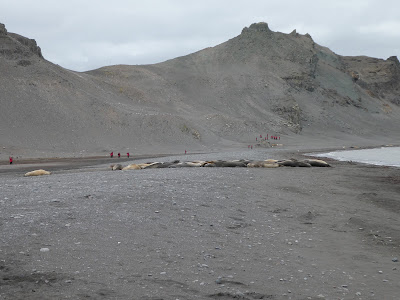***NOTE: This is the last posting for our trip to Antarctica. Start reading at the beginning of the posts by clicking on the link above in the listing of previous travels entitled: ANTARCTICA! The White Wilderness.
After disembarking the ship in Ushuaia, we flew to Buenos Aires, spent one night there and then flew to Iguazu Falls.
We have been to Iguazu Falls before--twice, in fact. But what can I say....we LOVE waterfalls and each time we visit, we see the falls a little differently due to varying water levels. Last time we were here, the water level was unusually high; this time, a different story.
Our early flight brought us to the Argentinean Iguazu airport by midmorning. What a change from Antarctica...it is hot and humid. We then set off to cross the border to view the falls from the Brazil side.
Located on the Argentina/Brazil border, the falls are among the world's most impressive sights. They are twice as high as Niagara Falls and 65 feet wider with 275 cascades stretching over 1.5 miles.
There is rain in those clouds as we wait at the border crossing for our passports to be stamped. It lasts for several minutes and then stops.
Once we are inside the national park, the rain starts coming down again. We quickly get out our rain gear and walk the stone path to our first look at the falls.
Through the low clouds and rain, we can barely see the falls. And we gasp as there is not much water flowing--definitely not what we last saw when here two years ago. Our guide explained that there had not been much rain during the past several weeks and that there is a dam up river that controls the amount of water that will be released over the falls.
It still is a breathtaking site and we are anxious to walk down the trail and be closer to the falls.
We know there are some great viewpoints coming up as we descend to the main part of the falls..
We reach the boardwalk that takes us out for a full view of the Brazilian side of Iguazu Falls. There are plenty of visitors in the park today!
We walk closer to the base of the falls
There is an elevator at this point that will take us up to the top of the falls.
And here's what it looks like from above. It truly is breathtaking, even if the waterflow is down a bit.
The next day we spend the day seeing the falls on the Argentina side. Once inside the park, we walk about 1/2 mile on the catwalks...
to the "Devil's Throat".
It's a U-shaped chasm where 14 falls plunge more than 350 feet.
so, as we have done on previous visits, we opt for the professional cameraman to take our photo.
We walked on the catwalks right over the streams that would soon become a cascading waterfall.
Some of the streams had very little water flowing over the ridge
And some had none. Of the 275 cascades that make up Iguazu Falls, we were told that only about 250 of them actually had water flowing over.
That afternoon we took a fun boat ride on the river and headed to the falls.
The boat actually goes underneath the falls at two different spots.
Here's a few photos taken from the video we purchased of the ride under the falls.
In we go...
We loved it! Do it again...
What a fun experience!!
It was great visiting the falls again. We never tire of it.
If you made it all the way through this trip's postings, here's a few bonus photos of Iguazu. On a previous visit I purchased a CD with professional photos.
First, an aerial view of all Iguazu Falls. It is one of the Seven Natural Wonders of the World.
The water is really flowing on these professional photos.
On her first sighting of Iguazu Falls, first lady Eleanor Roosevelt exclaimed: “Poor Niagara!”
Thank you for following along on our adventure through this travel blog. I like having the blog to relive the wonderful adventures Terry and I have been able to experience....just looking at the photos brings to life the memories of an adventure of a lifetime!
Our next adventure is planned for the summer of 2020. Originally we had a month-long trip planned to Mongolia, China, Tibet and Cambodia. With the recent corona virus epidemic threatening lives throughout China and into many other countries, that trip is cancelled.
But, Overseas Adventure Travel is great--we just moved all the money paid over to another trip: A small-ship adventure along the coast in the Adriatic Sea starting in Croatia and ending in Greece. Hopefully travel will be possible this summer. We're keeping our fingers crossed!!
UPDATE: Well, this trip was cancelled as well as a small-ship trip on the Turkish Coast and Greek Islands for late summer. Hopefully we can start traveling again.... if not in late 2020, then by 2021.
So stay tuned!! And if the "Travel Bug" has bit you, check out Overseas Adventure Travel/Grand Circle Travel and if you book a trip, mention our names for a referral, Terry and Joyce Angell and #1883762...you will receive a $100pp discount on your first trip!




































































